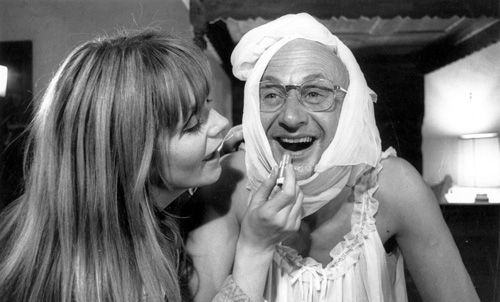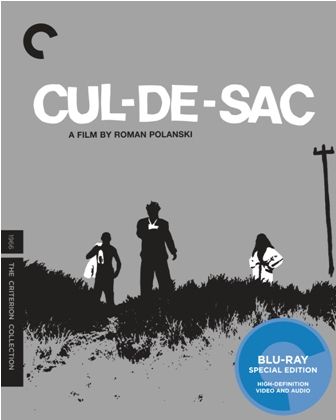A Cul-de-sac is defined as a road that leads nowhere. And in Roman Polanski’s film of the same name, this is never made literal. It’s easy to imagine the simplified version that would have some visual metaphor for this road, but the title is more indicative of the narrative. Donald Pleasence and Francios Dorleac play a married couple whose home (a castle!) is invaded by a gangster (Lionel Stander). The film combines Polanski’s dark sense of humor with his fascination with claustrophobia, and though it doesn’t reach the heights of his best work, it’s must-see nonetheless. Our review of the Criterion Blu-ray of Cul-de-sac follows after the jump.
Though originally a Polish filmmaker, Polanski – after received tremendous attention and acclaim for his first film Knife in the Water – quickly moved abroad to shoot his next three films in London. His sensibilities never changed though regardless of location, though with these English films he usually had an international cast. And while Cul-de-sac is set in London, two of its three leads are outsiders. Which seems fitting with the film and Polanski’s portrait of alienation.
The film begins with Teresa (Dorleac) lying topless on a young man. Her marriage to George (Pleasence) seems to be that of an older wealthy man and a younger woman. Gangster Richard (Stander) was on a job with Albie (Jack Macgrowan) that went bad – Richard is shot in the arm, and Albie is dying. Richard has no idea what to do. They’re lost, their car stopped working and Richard knows they need a doctor or something. When he goes to George’s place, the couple is in the midst of some role-playing that defines their relationship: Teresa is dressing up George as a woman. George’s amused, but when they go downstairs to check on a possible break-in, it sets up how powerless George is right off the bat.
Richard holds them hostage, sort of. He’s takes them to Albie, but the tide has come in, and the car is flooded. Richard has to hole up for a little bit, but the inherent tension in the marriage also change the dynamics of the group, and the couple have some friends show up, including the man who’s sleeping with Teresa.
At the time the film was made in 1966, playwrights like Harold Pinter and Samuel Beckett were playing with form and content in a way that made it a movement called the theater of the absurd, one that rarely made its way to the screen. But Polanski was obviously in tune with this, and his work here is very much of that sensibility. But what’s also interesting is that this subsequently became a subgenre of cinema, one that often makes all too any mistakes. The uninvited guest, and the turnabout of a hostage situation is familiar, but Polanski never plays by the rules that came later. First and foremost, he has no interest in making anyone sympathetic. The wife would usually be the character who is given empathy, but the film starts with her cuckolding her husband, and the husband is thoroughly emasculated early on.
And then there’s the American gangster in the middle of England. The film may prove outwardly alienating, but there’s a lot at work here, and Polanski’s sense of rhythm and cinema keep it from falling into the pitfalls of the genre. He also keeps the audience at a certain distance. But then it also connects to a lot of Polanski’s other work with the three person layout similar to his earlier Knife in the Water, and later Death and the Maiden. To that end, his latest – Carnage, which is currently playing the festival circuit – explores similar themes. These films are about outsiders coming into a situation and some form of imprisonment together.
But on top of that, Polanski is an immaculate craftsman, and watching the film is fascinating for how he uses and places the camera. Polanski has rarely made movies that are poorly put together, and here he’s on top of his game. Polanski used to call this his favorite film. I don’t know if I’d call it his best, but it’s definitely pure and uncut Polanski, that’s for sure.
Criterion’s Blu-ray presents the film in original aspect ratio (1.66:1) and in 2.0 monaural sound. The picture quality is what we’ve come to expect from Criterion, and the black and white imagery absolutely crackles on Blu-ray. The film was never released stateside on home video - this is a huge treat – but there was a Region 2 box set of his first three films, and most of the supplements come from that. “Two Gangsters and an Island” (23 min.) was made for the set, and it offers comments from Polanski, producer Gene Gutowski, and cinematographer Gilbert Taylor. They talk about the troubled production, and about some of Polanski’s ideas behind making the film. There’s also “The Nomad” a 1967 interview with Polanski (27 mi.), where he walks through his career to that point. Polanski is a smart cookie, so it’s worth a watch. Also included are two trailers.




